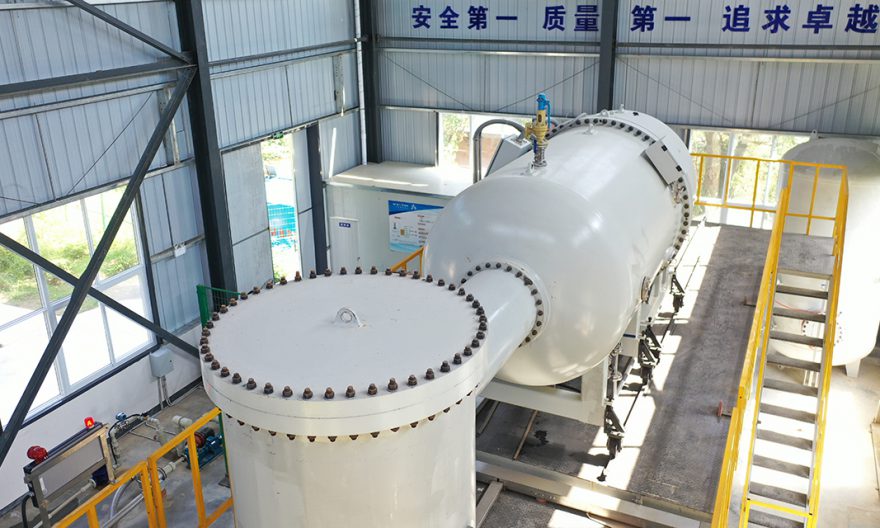
Recently, China has inaugurated Asia’s first demonstration facility for medical wastewater treatment using electron beam (EB) technology, according to a report from International Atomic Energy Agency (IAEA). “This is the first pilot-scale – 400 cubic meters per day – demonstration of EB for medical wastewater treatment,” said Shijun He, a Professor at the Institute of Nuclear and New Energy Technology (INET) at Tsinghua University.
“The further application of EB technology to medical wastewater treatment demonstrates China’s ongoing progress and the tangible socio-economic and environmental impact of the IAEA transferring nuclear technology to address development priorities,” said Gashaw Wolde, Section Head for technical cooperation with Asia and the Pacific at the IAEA.
Science Direct Journal indicates that the development of electron beam technology for environmental purposes has gained attention not only because of several important and hard contaminants reaching waters, soil and groundwater but also due to the capability of degrading organic molecules. Ionizing radiation for the environmental area may be obtained from cobalt-60 (gamma radiation) or from Electron Beam Accelerator (EBA), which seems to be more suitable for environmental applications.
The rapid rate of industrialization, urbanization and population growth in developing countries calls for the creation of an efficient system for the disposal of solid waste and wastewater treatment. Ethiopia is one of the rapidly growing countries in Africa. It is investing hugely in urban development and industrialization.
This causes the generation of a large volume of solid waste and wastewater. The disposal and treatment of waste is a headache especially for developing countries as it needs finance and technology. Choosing appropriate technology for the treatment and recycling of the waste then depends on the economic situation of countries.
The problems associated with wastewater disposal have become an inevitable problem in the urban world due to the increase in human population and urbanization. The commonality of wastewater-related problems throughout coastal areas of the world is significant since these areas are inhabited by over 60 percent of the human population. Consequently, domestic wastewater discharge is considered a significant threat to the coastal environments worldwide. Environmental effects associated with wastewater discharges are generally local with transboundary implications in some areas. The adverse public health, environmental, socio-economic, food quality and security and esthetic impacts from wastewater contamination in coastal areas are well documented.
Among the technologies applied for solid waste disposal and wastewater treatment, Electron Beam is becoming a famous and preferred one. While the technology needs due investment which would be challenging for developing countries the return is worth paying for.
Research also indicates that e-beam treatment is a viable solution for treating wastewater, sludge and flue gases. Remediation of wastewater, sludge and removal of objectionable substances from the environment using radiation technology is neglected. Hardly, a couple of decades ago, the application of electron beam (EB) technology have gained attention for waste management. When wastewater is irradiated with an electron beam, the beam can alter the physicochemical properties of irradiated aqueous material and also transform wastewater chemicals due to the excitation or ionization of chemical molecules.
Thus, chemical reactions may be capable of producing new compounds. The beam of electrons initiates primary reactions to induce the excitation or ionization of molecules at varied rates. This review paper will help a budding researcher how to optimize the irradiation process to achieve high efficiency with low electron beam energy which is economically viable/feasible. Application of E-beam radiation for wastewater treatment may ensure future smart cities with sustainable water resources management.
In the last few decades, electron beam technology for pollution mitigation has substantiality gaining importance all over the world. This development is a result of the new possibilities in the face of environmental constraints and generally highly productive processes that are amenable to automation. Low, medium and high voltage electron beam facilities have been widely used in thermal techniques, such as evaporation, welding, melting and electron beam machining. The electron beam has also been used in radiation techniques, for instance cross-linking of polymers, vulcanization of natural and synthetic rubber, paint curing, polymerization and depolymerisation, sterilization of food, medical products, and municipal sewage.
The electron beam radiation has ample suitable for advanced oxidation technologies for both water purification and flue gases in environmental pollution mitigation. The dominating applications in the electron beam radiation field are cross-linking of cable insulation, electronic treatment of plastic tubes, and sterilization of medical products and food.
The electron beam treatment of sewage sludge, water and flue gases has still been in a developmental stage. In all the above-mentioned cases, processing at a high rate, low processing temperature and low specific energy expenditure can be seen as benefits of electron beam radiation. Since the reaction process in electron beam radiation technology requires no catalysts, activators, other additives and relatively pure final product may be obtained. The advantages of electron beam application in radiation processing are the ability to direct radiation to the point of action, free choice of electron energy with power, facility for matching processing requirements, implementation of high dose rates, controlling and disconnecting of the radiation source at any time and the final availability of high beam powers.
BY STAFF REPORTER
The Ethiopian herald 15/2021





